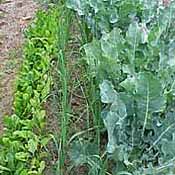|
You are the artist,
and your freshly-tilled garden is your blank canvas! A few minutes sketching
out different layouts can help you get started. Let’s consider a
few options.
Single rows
or wide beds?
If space
is at a premium, creating 3- to 4-foot-wide beds will allow you to grow
more plants than if you plant in long single rows, because less space
is used for paths. Plants in wide rows can be spaced closer together,
making it easier to weed, feed, and water them.

Raised
beds?
A raised
bed can be a simple mound of soil or an elaborate wood or stone structure.
There are a number of benefits to creating raised beds:
- Soil dries out
more quickly and warms up sooner in spring.
- Elevating plants
means less bending.
- Pathways are more
defined, so you (and your visitors) are less likely to trample new plantings.
- You can make a
garden where the existing soil is poor.
If you have sandy
soil or live in a region prone to prolonged heat and drought, avoid simple
mounded beds, because they can heat up and dry out too much.
Temporary
or permanent beds?
If you create
permanent beds:
- You can concentrate
your soil-building efforts where they matter most -- in the beds, rather
than in the paths.
- You can eliminate
soil compaction, since you won’t be walking in the beds.
- You can take some
long-term weed control measures in the walkways.
If your beds are temporary:
- You can till the
entire garden each year.
- You can change
your garden design as you wish.
- It may make crop
rotation easier.
If you’re unsure
what layout to use, experiement with the different strategies and see
what works best for you.
|
|

Wide
beds save space.
|
|

Consider
designating one section of the garden for your children, and let
them be involved in planning, planting, and maintaining it.
Help young children
select easy and quick-growing plants like sunflowers and beans.
|
|

The
paths in this garden are permanent -- they have been mulched with
wood chips.
|
|